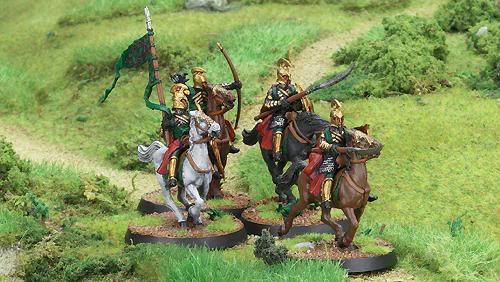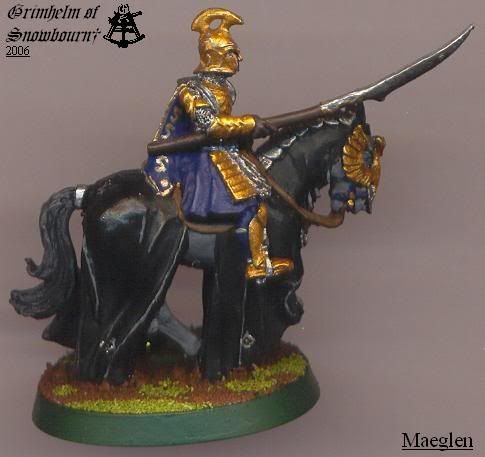[h1]A Discussion of Elven Cavalry, commonly referred to as "Elnaith"[/h1]
[h2]Introduction[/h2]
Firstly, what are Elnaith? Well, admittedly, the name is a GW invention, which first appeared in this article:
http://uk.games-workshop.com/elves/elf-cavalry/1/
The discussion is whether Elves used cavalry, and to what extent they did. For the discussion, we will only be concerning ourselves with Elves in the First and Second Ages (ie. before Sauron's defeat at the end of the Last Alliance) - in the Third Age the Elves were a dwindling race.
[h2]Arguments[/h2]
[h3]The Last Alliance, the name[/h3]
Games Workshop portrays the Elves of The Last Alliance as fielding light cavalry:

Although the name itself is a GW invention, it does use elements of Quenya - indeed, the idea could be said to be "historically based". The term "Dirnaith" is a term Tolkien used to refer to an aggressive tactic of the Numenoreans at the Last Alliance - the term literally meant "Man Spear", and referred to a quickly moving wedge of spearmen on foot, used to break apart the Orc formations. By this logic, "Elnaith" means "Elf Spear", and using their mastery of horses, they could conceivably form a cavalry wedge. Since the Elves we see in the film form an infantry shield wall, any wedge they formed would have been a cavalry wedge (as the Rohirrim did later at the Battle of the Pelennor Fields). This would be faster and better at flanking than the Numenorean formation, which would have formed the bulk of the armies' numbers, so the Elves really would be the small elite on the battlefield.
Now this shows that it would be tactically likely to have cavalry during the Last Alliance, but what did Tolkien say about Elven mounts?
[h3]Horse-masters[/h3]
Well, we might as well start with the Elves' use of horses in the Third Age:
Asfaloth was the white horse of Glorfindel towards the end of the Third Age, with a pace that was light and smooth but swift. Glorfindel departed Rivendell in search of Frodo, riding Asfaloth using a saddle with stirrups. They encountered three Nazgul at the Last Bridge, pursuing them until they recovered Frodo (this role was given to Arwen in the film). From
http://www.tuckborough.net/horses.html:
Quote:
Asfaloth turned and neighed fiercely at the Nazgul on the opposite bank... Asfaloth reared and snorted as the Nazgul approached, but then the waters of the Bruinen rose commanded by Elrond and Gandalf and the Nazgul were swept away.
Secondly we have Arod, which originally belonged to a Rider of Rohan, but was given to Legolas after his master died. From the same site:
Quote:
Arod was a fiery and restive horse, but Legolas rode him easily without saddle or rein. Gimli was not so comfortable on Arod, and he clung to his friend uneasily...
Legolas rode Arod to Meduseld and on to Helm's Deep. When Aragorn decided to take the Paths of the Dead, Legolas went with him, but Arod was reluctant to enter the Dark Door. Arod trembled in fear until Legolas laid his hands on the horse's eyes and sang to him. Arod then followed Legolas through the tunnels as the Dead gathered behind them.
Both these cases are interesting. Asfaloth stands up to the Nazgul - the Harbingers of Evil in Middle-earth - while Arod was calmed so that he could pass among the Army of the Dead. In both passages, it shows that the Elves of the late Third Age were
very skilled horse-riders, and could calm their mounts in the face of danger or battle - both very useful skills if cavalry were ever needed.
But while that's interesting on its own, it doesn't expressly show the use of cavalry in the Second Age. Fortunately, we have evidence of this two:
[h3]Cavalry in the First Age[/h3]
Quote:
"The watchfires burned low, and the guards were few; on the plain few were waking in the camps of the horsemen of Hithlum."
- The Silmarillion, Chapter 18
On the Games Workshop forum, fingolfin331 wrote:
This idea of horsemen makes sense beacuse the Plain of Arg-galen and Hithlum were a large part of the Noldor lived was perfect horse country, rolling plains. The elves were clever tacticains and would not have wasted such prime conditions for cavalry.
I would like to add something to that. They wouldn't get to be called the "Horsemen of Hithlum" if they did not use their horses in a form of cavalry. The "Riders of Rohan" would not have earned their name if they had not achieved the reputation on the battle-field. At the Nirnaeth Arnoediad, or "Battle of Unnumbered Tears", there were 15,000 to 20,000 Elves of Hithlum. But do we have evidence that Elves used cavalry in battle? Well, actually we do:
Quote:
"Now his wrath [Gwindor of Nargathrond] was kindled to madness, and he lept forth on horseback, and many riders with him: and they pursued the heralds and slew them, and drove deep on into the host."
-The Silmarillion, Chapter 20, page 226; HarperCollins edition.
There were at least 500 Elves of Nargathrond at this battle. Gwindor's charge which started the battle is express proof of cavalry, but we must also understand the definition. "Cavalry" does not necessarily mean a standing army - this is something which has fluctuated throughout history. During the early Middle Ages, armies were often composed of levied militia. The Romans used cavalry auxiliaries, which were not in every army because they were limited to the wealthy class known as the "Equites" (those who could afford the expense of maintaining a horse and the necessary armour).
So, any riders in numbers on the battle-field were effectively cavalry. The Rohirrim, for example, did not go on manouevres and routine training exercises, nor were they paid for military service. They learned from their own experience at their homesteads, and would be called up to fight if the area was attacked or (in the case of the War of the Ring) they were going to aid Gondor.
At the aforementioned Battle of Unnumbered Tears, the important line to me is that they "drove deep on into the host". To me, this indicates heavy cavalry. Again, the Elnaith "wedge" I mentioned earlier explains how they were able to get so deep into the enemy lines. I believe the Elven lords of Gondolin would have had such heavy cavalry too, comparable to the Roman Equites, as Gondolin itself was a rich, urban stronghold. This is my own conversion depicting such a lord of Gondolin, mounted on a caparisoned horse:

[h2]Conclusion[/h2]
To recap, I believe that the Elves of the urban centres at Nargathrond and Gondolin used heavy cavalry during the Wars of Beleriand. The Elves of the plains of Hithlum used lighter cavalry. By the time of the Last Alliance, they used light cavalry to create wedge formations, which may be described accurately (if not canonically) as "Elnaith". By the end of the Third Age, the Elves of Rivendell only used riders in small numbers or for scouting, and did not engage in battles involving cavalry.
The site currently has two articles on converting light High Elf cavalry:
http://www.one-ring.co.uk/index.php?pag ... &artid=543
http://www.one-ring.co.uk/phpBB2/kb.php ... icle&k=236
Why have I written this? Well, I plan to write my own article on coverting heavy Elf cavalry (ie. the captain above), and I plan to use this for an introduction on "Elnaith" in general. Your thoughts?

(NB: I have an article on painting Numenoreans to finish first, then I will get to work on this topic's article)
Note also the poll, which deals with the events of the First and Second Age.

 Top
Top Top
Top Top
Top Top
Top Top
Top Top
Top Top
Top Top
Top Top
Top Top
Top Top
Top Top
Top Top
Top Top
Top Top
Top Top
Top Top
Top Top
Top Top
Top Top
Top









 After all, the Lothlorien elves were originally called the tree-elves, which leads me to believe that cavalry for them would be somewhat rarer.
After all, the Lothlorien elves were originally called the tree-elves, which leads me to believe that cavalry for them would be somewhat rarer.




